Howea forsteriana
| Howea forsteriana | |
|---|---|
 | |
| H. forsteriana in habitat | |
| Scientific classification | |
| Kingdom: | Plantae |
| (unranked): | Angiosperms |
| (unranked): | Monocots |
| (unranked): | Commelinids |
| Order: | Arecales |
| Family: | Arecaceae |
| Subfamily: | Arecoideae |
| Tribe: | Areceae |
| Subtribe: | Linospadicinae |
| Genus: | Howea |
| Species: | H. forsteriana |
| Binomial name | |
| Howea forsteriana Becc. | |
| | |
| H. forsteriana is endemic to Lord Howe Island | |
Howea forsteriana (Kentia Palm or Thatch palm) is a species of flowering plant in the palm family Arecaeae, endemic to Lord Howe Island in Australia. It is also widely grown on Norfolk Island. It is a relatively slow-growing palm, eventually growing up to 10 m (33 ft) tall by 6 m (20 ft) wide. Its fronds can reach 3 m (10 ft) long.[1]

The species is considered vulnerable by the World Conservation Union. It is cultivated on Lord Howe Island by collecting wild seeds and germinating them for export worldwide as an ornamental garden or house plant. The trade in the seeds and seedlings is tightly regulated.
The palm is an elegant plant, and is popular for growing indoors, requiring little light. Out of doors, it prefers a tropical region but will also grow in a cooler climate, and can tolerate temperatures down to -5 °C, but only for a few hours; normal temperatures should not go below 10°. It grows readily outside in areas such as southern Australia and northern New Zealand, where it is fairly common in private gardens or as a street tree. In the Northern Hemisphere, it can be grown as far north as southwest England, and grows well in the south of Spain and the southern United States, and will bear flowers and fruit. In the United States, the kentia palm is often used in Florida and California in tropical plantings because it closely resembles the coconut palm, which can only grow in the warmest parts of Florida. The coasts of the southeastern Azores and Madeira offer climates similar to its original habitat. It is slow growing, but will eventually reach heights of 6 to 18 metres. Under natural conditions, it grows as a solitary tree. Germination of the seeds is erratic.
The closely related Belmore sentry palm (Howea belmoreana), also endemic on Lord Howe Island, is a smaller species to 7 metres tall, found mainly as an understorey plant in moist forests.

Cultivation
Howea Forsteriana gained great popularity as a houseplant in Europe during the Victorian era, at a time when exotic palms and other plants were avidly collected in England and elsewhere. The Kentia became the quintessential 'parlor palm' beginning in the 1870's, when exports from Lord Howe Island first started. In part this was because the plant thrived in interiors where low light, low humidity, poor air quality and cool temperatures made palms otherwise impossible to grow.[2] This resistance to erratic conditions also made Kentias suitable for transporting as seedlings on long ocean voyages. Another reason for their popularity is attributable to Queen Victoria, who cultivated them in all of her homes and left instructions for Kentia palms to be placed around her coffin while she lay in state.[3] The association with royalty and the fact that Kentias were quite expensive to buy gave those who could furnish their homes with them a certain prestige.
The Palm Courts which became popular in Edwardian hotels like those of the The Ritz Hotel in London or the Plaza Hotel in New York all featured Kentia palms, aesthetically pleasing because of their architectural, drooping fronds and the great height they reach at maturity.
A potted Kentia palm sold in modern-day garden centers generally does not consist of one palm but 2 to 5, planted in clusters as seedlings to give the plant a shrubbier look. They remain relatively expensive to purchase, because the export of seeds from Lord Howe Island is strictly controlled, the germination rate for seeds is low, and the plant is a slow grower, requiring years of nurturing to reach salable size. In Europe Kentias are primarily nursery-grown in Holland and then sold throughout the continent.[4] They are more popular, less expensive, and easier to purchase in European countries than they are in the United States, where much of the commercial growing is done in Hawaii before plants are brought to the mainland.
References
- ↑ RHS A-Z encyclopedia of garden plants. United Kingdom: Dorling Kindersley. 2008. p. 1136. ISBN 1405332964.
- ↑ Ian Hutton (2002-08-22). [<http://www.palmsociety.org/public/english/chamaerops/013_4.shtml "The History of Howeia"] Check
|url=value (help). The European Palm Society. p. 4. - ↑ Steve Chawkins (2011-10-26). "Market for exotic palms goes to pot". Los Angeles Times. Retrieved 2017-05-20.
- ↑ Ian Hutton (2002-08-22). [<http://www.palmsociety.org/public/english/chamaerops/013_4.shtml "The History of Howeia"] Check
|url=value (help). The European Palm Society. p. 4.
- Johnson (1998). "Howea forsteriana". IUCN Red List of Threatened Species. Version 2006. International Union for Conservation of Nature. Retrieved 11 May 2006. Listed as Vulnerable (VU D2 v2.3)
| Wikimedia Commons has media related to Howea forsteriana. |
